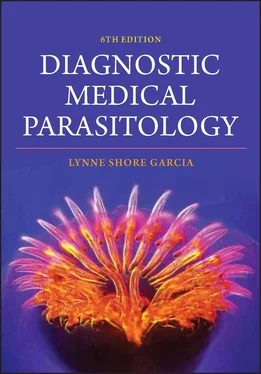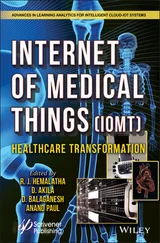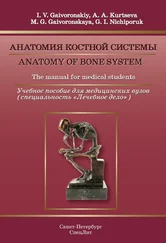Lynne Shore Garcia - Diagnostic Medical Parasitology
Здесь есть возможность читать онлайн «Lynne Shore Garcia - Diagnostic Medical Parasitology» — ознакомительный отрывок электронной книги совершенно бесплатно, а после прочтения отрывка купить полную версию. В некоторых случаях можно слушать аудио, скачать через торрент в формате fb2 и присутствует краткое содержание. Жанр: unrecognised, на английском языке. Описание произведения, (предисловие) а так же отзывы посетителей доступны на портале библиотеки ЛибКат.
- Название:Diagnostic Medical Parasitology
- Автор:
- Жанр:
- Год:неизвестен
- ISBN:нет данных
- Рейтинг книги:3 / 5. Голосов: 1
-
Избранное:Добавить в избранное
- Отзывы:
-
Ваша оценка:
- 60
- 1
- 2
- 3
- 4
- 5
Diagnostic Medical Parasitology: краткое содержание, описание и аннотация
Предлагаем к чтению аннотацию, описание, краткое содержание или предисловие (зависит от того, что написал сам автор книги «Diagnostic Medical Parasitology»). Если вы не нашли необходимую информацию о книге — напишите в комментариях, мы постараемся отыскать её.
Diagnostic Medical Parasitology — читать онлайн ознакомительный отрывок
Ниже представлен текст книги, разбитый по страницам. Система сохранения места последней прочитанной страницы, позволяет с удобством читать онлайн бесплатно книгу «Diagnostic Medical Parasitology», без необходимости каждый раз заново искать на чём Вы остановились. Поставьте закладку, и сможете в любой момент перейти на страницу, на которой закончили чтение.
Интервал:
Закладка:
Amphotericin B (AmBisome) (Gilead)
Amphotericin B (Fungizone) (X-Gen)
Artemether (Artenam) (Aarenco, Belgium)
Atovaquone (Mepron) (GlaxoSmithKline)
Atovaquone-proguanil (Malarone) (GlaxoSmithKline)
Benznidazole (Rochagan) (Roche, Brazil)
Bithionol (Bitin) (CDC)
Chloroquine phosphate (Aralen) (Sanofi, others)
Crotamiton (Eurax) (Ranbaxy)
Dapsone (Jacobus)
Diethylcarbamazine citrate USP (Hetrazan) (CDC)
Diloxanide furoate (Furamide, Entamide) (Boots, England)
Eflornithine (difluoromethylornithine, Ornidyl) (Sanofi) (CDC)
Fumagillin (Fumidil-B)
Furazolidone (Furoxone)
Iodoquinol/diiodohydroxyquin (Yodoxin) (Glenwood, others)
Ivermectin (Stromectol, Sklice) (Merck, Sanofi)
Lumefantrine/artemether (Coartem, Riamet) (Novartis)
Malathion (Ovide) (Taro Pharmaceuticals)
Mebendazole (generics)
Mefloquine hydrochloride (generics)
Melarsoprol (Mel-B) (CDC)
Metronidazole (Flagyl, IV Flagyl) (Searle/Pfizer, Baxter)
Miltefosine (Impavido, Miltex) (Paladin, Canada) (CDC)
Niclosamide (Yomesan, Niclocide) (Bayer, Germany)
Nifurtimox (Lampit) (Bayer HealthCare) (CDC)
Nitazoxanide (Alinia) (Romark)
Paromomycin (generics) (Sun Pharma)
Pentamidine isethionate (Pentam 300, Nebupent) (APP Pharmaceuticals)
Permethrin (Nix [Insight Pharmaceuticals], Elimite [Prestium Pharma])
Polyhexamethylene biguanide (Baquacil) (Zeneca)
Praziquantel (Biltricide) (Bayer)
Primaquine phosphate (Sanofi-Aventis)
Propamidine isethionate (Brolene) (Aventis, Canada)
Pyrantel pamoate (Pin-X, Reese’s Pinworm Medicine) (Quartz Specialty Pharmaceuticals, Reese)
Pyrethrin with piperonyl butoxide (Rid) (Bayer, others)
Pyrimethamine (Daraprim) (Amedra)
Quinidine gluconate (generics)
Quinine sulfate or quinine dihydrochloride (many manufacturers)
Spiramycin (Rovamycine) (Sanofi-Aventis)
Stibogluconate sodium (Pentostam, Solustibosan) (GlaxoSmithKline) (CDC)
Suramin sodium (Germanin) (Bayer, Germany) (CDC)
Thiabendazole (Mintezol) (Merck)
Tinidazole (Tindamax) (Mission Pharmaceuticals)
Triclabendazole (Egaten) (Novartis)
APPENDIXES
APPENDIX 1 Information Tables
A1.1 Classification of human parasites
A1.2 Distribution of selected parasitic infections in the Americas
A1.3 Distribution of selected parasitic infections in Europe
A1.4 Distribution of selected parasitic infections in Africa
A1.5 Distribution of selected parasitic infections in Asia
A1.6 Distribution of selected parasitic infections in Oceania
A1.7 Cosmopolitan distribution of common parasitic infections (North America, Mexico, Central America, South America, Europe, Africa, Asia, and Oceania)
A1.8 Body sites and specimen collection
A1.9 Body sites and possible parasites recovered (trophozoites, cysts, oocysts, spores, adults, larvae, eggs, amastigotes, and trypomastigotes)
A1.10 Body site, specimen and procedures, recommended methods, relevant parasites, and comments
A1.11 Examination of tissue and body fluids
A1.12 Key characteristics of protozoa of the intestinal tract and urogenital system
A1.13 Key characteristics of tissue protozoa
A1.14 Key characteristics of helminths
A1.15 Key characteristics of most common parasites found in blood
A1.16 Diagnostic laboratory report information that should be relayed to the physician
A1.17 Pros and cons of stool specimen collection and testing options
A1.18 Approaches to stool parasitology: test ordering
A1.19 Pros and cons of ova and parasite examination options
A1.20 Laboratory test reports: optional comments
A1.21 Estimated prevalence of parasitic diseases worldwide
APPENDIX 2 Flowcharts and Staining Tables for Diagnostic Procedures
Flowcharts
A2.1 Procedure for processing fresh stool for the ova and parasite examination
A2.2 Procedure for processing liquid specimens for the ova and parasite examination
A2.3 Procedure for processing preserved stool for the ova and parasite examination by using the traditional two-vial collection kit
A2.4 Procedure for processing sodium acetate-acetic acid-formalin (SAF)-preserved stool for the ova and parasite examination
A2.5 Use of various fixatives and their recommended stains: fecal specimens preserved using polyvinyl alcohol (PVA)
A2.6 Use of various fixatives and their recommended stains: fecal specimens preserved in the Universal Fixative, TOTAL-FIX
Tables
A2.1 Steps in the trichrome staining procedure (mercuric chloride-based PVA-preserved stool specimens)
A2.2 Steps in the trichrome staining procedure (non-mercuric chloride-based PVA-preserved stool specimens)
A2.3 Steps in the iron hematoxylin staining procedure (mercuric chloride-based PVA-preserved stool specimens) (Spencer-Monroe method)
A2.4 Steps in the iron hematoxylin staining procedure (mercuric chloride-based PVA-preserved stool specimens) (Tompkins-Miller method)
A2.5 Steps in the iron hematoxylin staining procedure (incorporating the carbol fuchsin step)
A2.6 Steps in the trichrome staining procedure (Universal Fixative [no mercury, no formalin, no PVA])
A2.7 Oil-mounted permanent stained smears (no Permount is used)
A2.8 Tips on stool processing and staining
APPENDIX 3 Common Problems in Parasite Identification
Figures
A3.1–A3.26 Paired drawings of “look alikes”
A3.27 Relative sizes of helminth eggs
Tables
A3.1 Entamoeba spp. trophozoites versus macrophages
A3.2 Entamoeba spp. cysts versus polymorphonuclear leukocytes (PMNs)
A3.3 Entamoeba histocolytica versus Entamoeba coli precysts and cysts
A3.4 Endolimax nana versus Dientamoeba fragilis
A3.5 Adult nematodes and/or larvae found in stool specimens: size comparisons
APPENDIX 4 Quality Control Recording Sheets
A4.1 Diagnostic parasitology quality control (QC) (reagents)
A4.2 Diagnostic parasitology quality control (QC) (reagents)—example for multiple reagents
A4.3 Diagnostic parasitology quality control (QC) (culture)—example of a worksheet
A4.4 Equipment maintenance
APPENDIX 5 Commercial Supplies and Suppliers
Tables
A5.1 Sources of commercial reagents and supplies
A5.2 Addresses of suppliers listed in Table A5.1
A5.3 Sources of available reagents for immunodetection of parasitic organisms or antigens
A5.4 Addresses of suppliers listed in Table A5.3
A5.5 Commercial suppliers of diagnostic parasitology products
A5.6 Sources of additional teaching materials, including case histories
A5.7 Sources of parasitologic specimens
APPENDIX 6 Reference Sources
APPENDIX 7 “Late-Breaking” Published Information
APPENDIX 8 Molecular Panels for Parasitology
APPENDIX 9 Frequently Asked Questions about Diagnostic Parasitology
APPENDIX 10 Current Procedural Terminology (CPT) Codes in Parasitology
GLOSSARY
INDEX
Preface
During the past few years, the field of diagnostic medical parasitology has seen dramatic changes, including newly recognized parasites, emerging pathogens in new geographic areas, bioterrorism considerations and requirements, alternative techniques required by new regulatory requirements, reevaluation of diagnostic test options and ordering algorithms, continuing changes in the laboratory test menus, implementation of testing based on molecular techniques, reporting formats and report comments, coding and billing requirements, managed-care relevancy, increased need for consultation and educational initiatives for clients, and an overall increased awareness of parasitic infections from a worldwide perspective. We have seen organisms like the microsporidia change from the status of “unusual parasitic infection” to being widely recognized as among the most important infections in both immunocompetent and compromised patients. With confirmation of the fifth human malaria, Plasmodium knowlesi, this field has expanded dramatically. More sensitive diagnostic methods for organism detection in stool specimens are now commercially available for Entamoeba histolytica, Entamoeba histolytica/E. dispar, Giardia lamblia, Cryptosporidium spp., and Trichomonas vaginalis. Reagents are actively being developed for other organisms such as Dientamoeba fragilis, Blastocystis spp., and the microsporidia. We have seen Cyclospora cayetanensis coccidia become well recognized as the cause of diarrhea in immunocompetent and immunocompromised humans. We continue to see new disease presentations in compromised patients; a good example is granulomatous amebic encephalitis caused by Acanthamoeba spp., Sappinia diploidea, and Balamuthia mandrillaris. With the expansion of transplantation options, many parasites are potential threats to patients who are undergoing immunosuppression, and these must be considered within the context of this patient group. Transfusion transmission of potential parasitic pathogens continues to be problematic. Transfusion in general is becoming more widely recognized as a source of infection, and donors are also more likely to come from many parasite-endemic areas of the world. It is also important to recognize the many neglected parasitic infections seen within the United States; indeed, the world continues to shrink in terms of infectious diseases.
Читать дальшеИнтервал:
Закладка:
Похожие книги на «Diagnostic Medical Parasitology»
Представляем Вашему вниманию похожие книги на «Diagnostic Medical Parasitology» списком для выбора. Мы отобрали схожую по названию и смыслу литературу в надежде предоставить читателям больше вариантов отыскать новые, интересные, ещё непрочитанные произведения.
Обсуждение, отзывы о книге «Diagnostic Medical Parasitology» и просто собственные мнения читателей. Оставьте ваши комментарии, напишите, что Вы думаете о произведении, его смысле или главных героях. Укажите что конкретно понравилось, а что нет, и почему Вы так считаете.












